
FLORIDA
OF THE SPANISH
THE STRUCTURE OF SPANISH COLONIALISM
THE FIRST GOVERNOR
The Spanish had found
in
Pedro Menendez de Aviles the
patient adelantado needed to develop a lasting community on the Florida peninsular. In
the important early years, Menendez personally developed the struggling
settlement at St. Augustine and since he could keep the
position for as long as he wished, he provided the continuity the colony
needed.
Menendez's first goal after the
defeat of the French was to gain the friendship of the native Floridians. After
years of mistreatment by conquistadores, the Indians had reason to fear the
European settlement. In the winter of 1566, Menendez took a small fleet around
the state. He had two motives. First, his son had been shipwrecked in the Gulf
and hoped to find him. Second, he wanted to sign the first treaty ever made
with the Calusa. He was
successful in the latter goal when the Calusa accepted a trade of Spanish gold
and sailors for more useful cloth and trading items. The Spanish, of course,
had more than religious and cultural conversion as goals in their Indian
policy. The Indians would provide a free labor supply to grow crops and raise
livestock for the coastal settlements.
Within two years Menendez fortified
the Atlantic coast line. He constructed stone forts at St.
Augustine and San Mateo (Fort Caroline) and wooden outposts at Santa Elena and San Felipe in present-day South Carolina. He built
watchtowers at Cape Canaveral and Biscayne Bay
to locate endangered treasure ships and pirate vessels. The entire system
provided the Spanish gold fleets with the added protective barrier against
coastal raiders.
Despite Menendez's coastal plan, Florida was still a
dangerous frontier outpost. When the adelantado visited Spain to recruit settlers, a revengeful French
trader named Dominic de Gourgues,
with the help of the Timucuans under a revengeful Saturiba, attacked and
destroyed San Mateo.


THE SPANISH COLONIAL SYSTEM
Florida was part of
the huge and complex Spanish mercantile empire, regarded with jealousy by the
rest of Europe for its size and wealth. Florida was a Royal
colony like all Spanish colonies. Florida was the lawful
property of the Spanish Crown and all appointments and decisions belonged to
the King, his advisors, and the Council
of the Indies in Havana.
The Council also served as Supreme Court in legal disputes. To improve
shipping, the Council set up the House
of Trade (Casa de Contratacion), which financed all missions and handled
the gold fleets.

In 1570, the Spanish Empire was
divided into two districts, New Spain (Mexico) and Peru, each with a viceroy selected by the king. Florida was a
province of New Spain, an area encompassing Mexico, Central America, Venezuela,
and the Caribbean
Islands. With such
rich colonies in the system, the viceroy regarded Florida as an impoverished backwater not
worthy of great financing nor promotion.
The Council was convinced only that Florida was of strategic military importance, as a front
door (with Cuba) to the Gulf of Mexico. Menendez' hopes to develop a plantation
economy was generally ignored by the Council. and it
was up to Menendez to interest investors in such projects.

SPANISH GOVERNORS
The Governor of La Florida was responsible for the
welfare of all the colonists. Havana
was three sailing days away. Yet La Florida
maintained the northern flank of protection for the great Spanish gold fleets.
In was thus logical that all of Florida's
Governors, including Menendez, had a military background or previous colonial
experience.
The Governor of Spanish Florida served as general of the army, chief justice of the court, business
manager for the colony's budget, diplomat to the Indians, welfare agent to the
poor, construction engineer for the colony's defenses, and religious leader.
Such power could have become dictatorial if the Spanish had not developed
clever procedures to oversee colonial officials.
By Royal edict, Florida
Governors served five years if they came from Europe
and three years if they came from another colony. It was, however, not usual
for governors to waits several years for their replacements to actually show
up.
Governors were required to post
one-half of their earnings in bond in Spain to pay any heavy fines
imposed for incompetence. Although Mennedez's successor, son-in-law Hernando de Mirando, was removed from
office, Florida
had a long history of dedicated leaders. There was little corruption, because
they all feared the residencia.
Near the end of a term of office, the Crown sent an undercover agent to
evaluate the Governor and the colony. The recommendation from this visita
was final.


MILITARY DUTIES
The Castillo de San
Marco, St Augustine 1672-1696
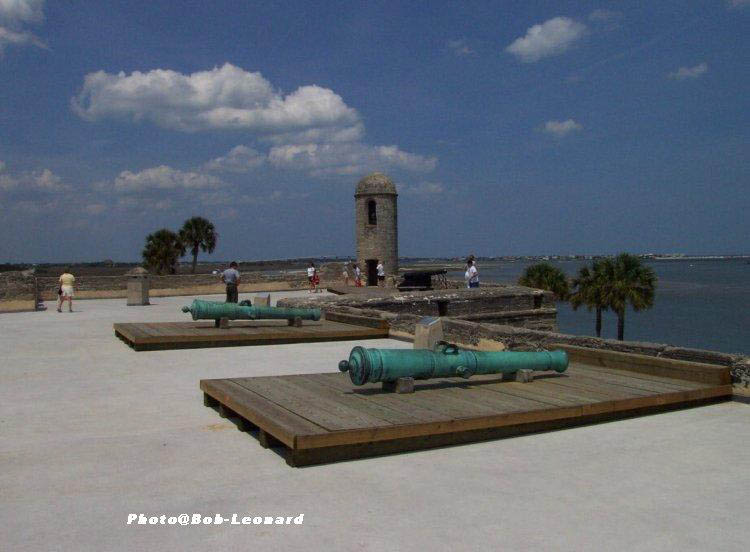
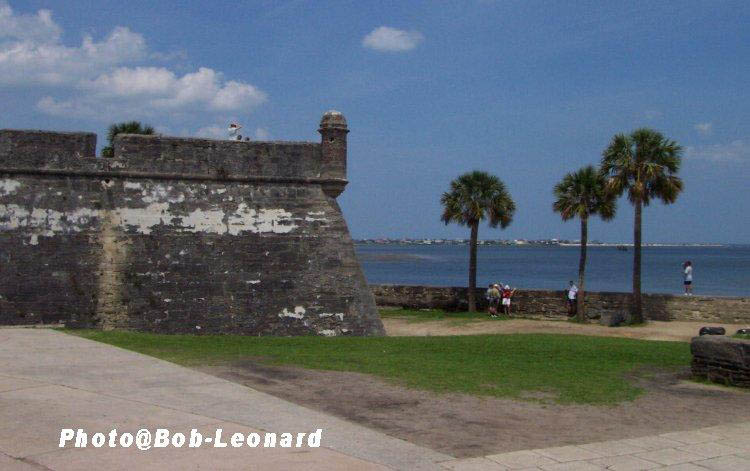
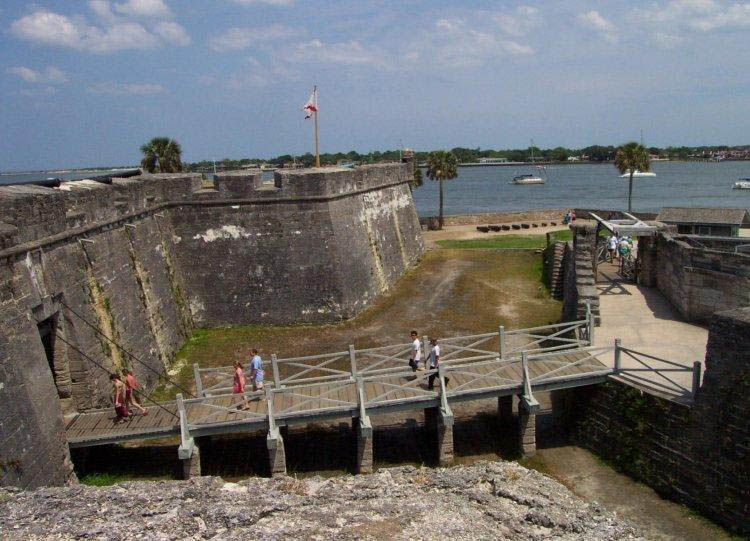
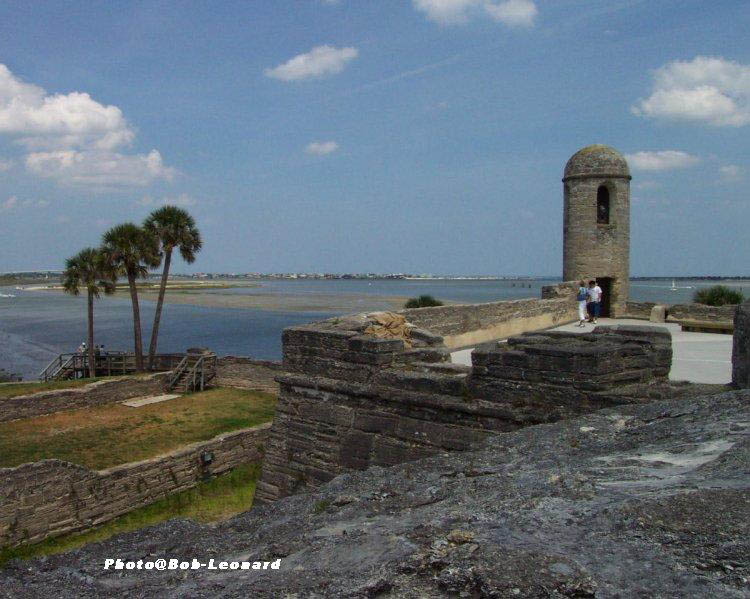
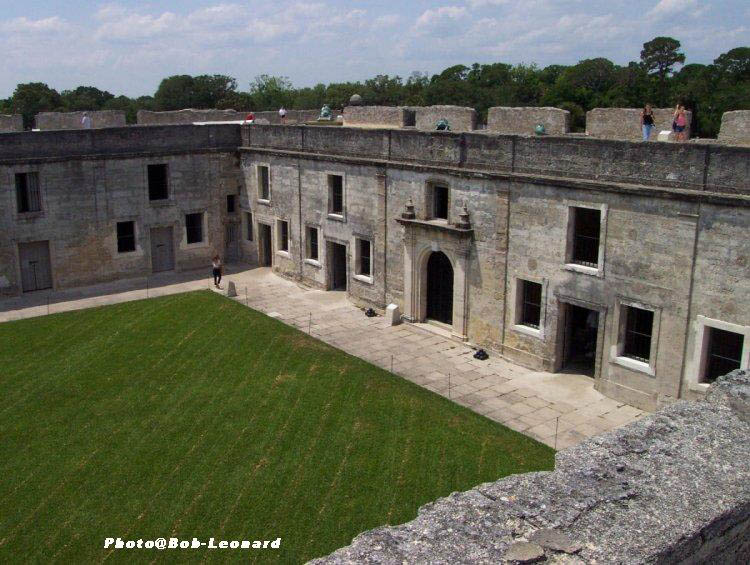
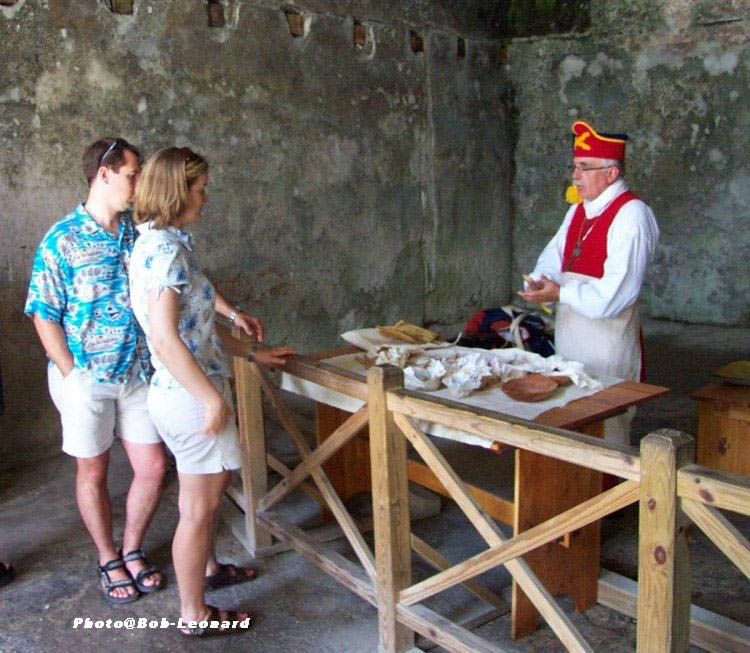
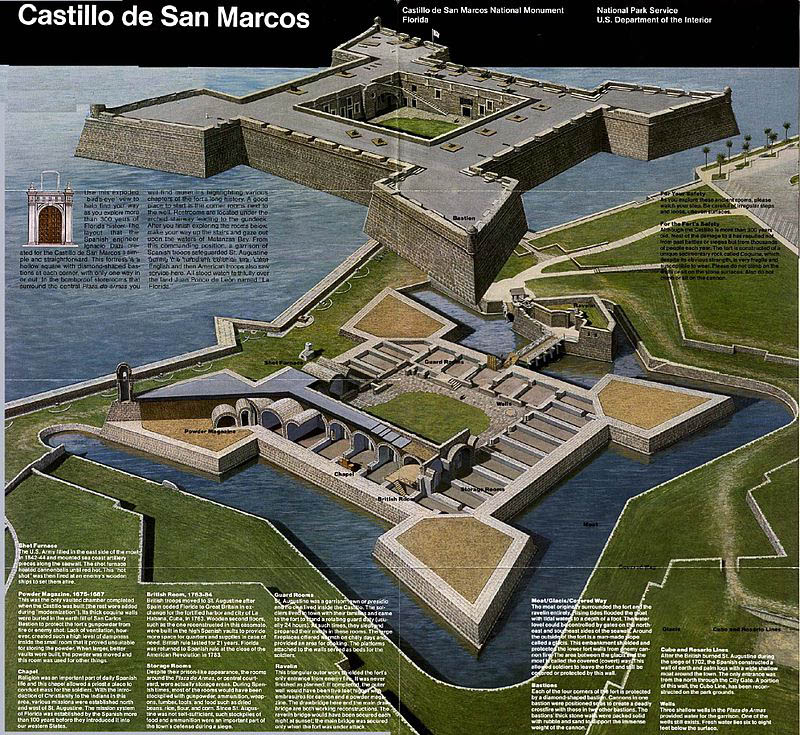
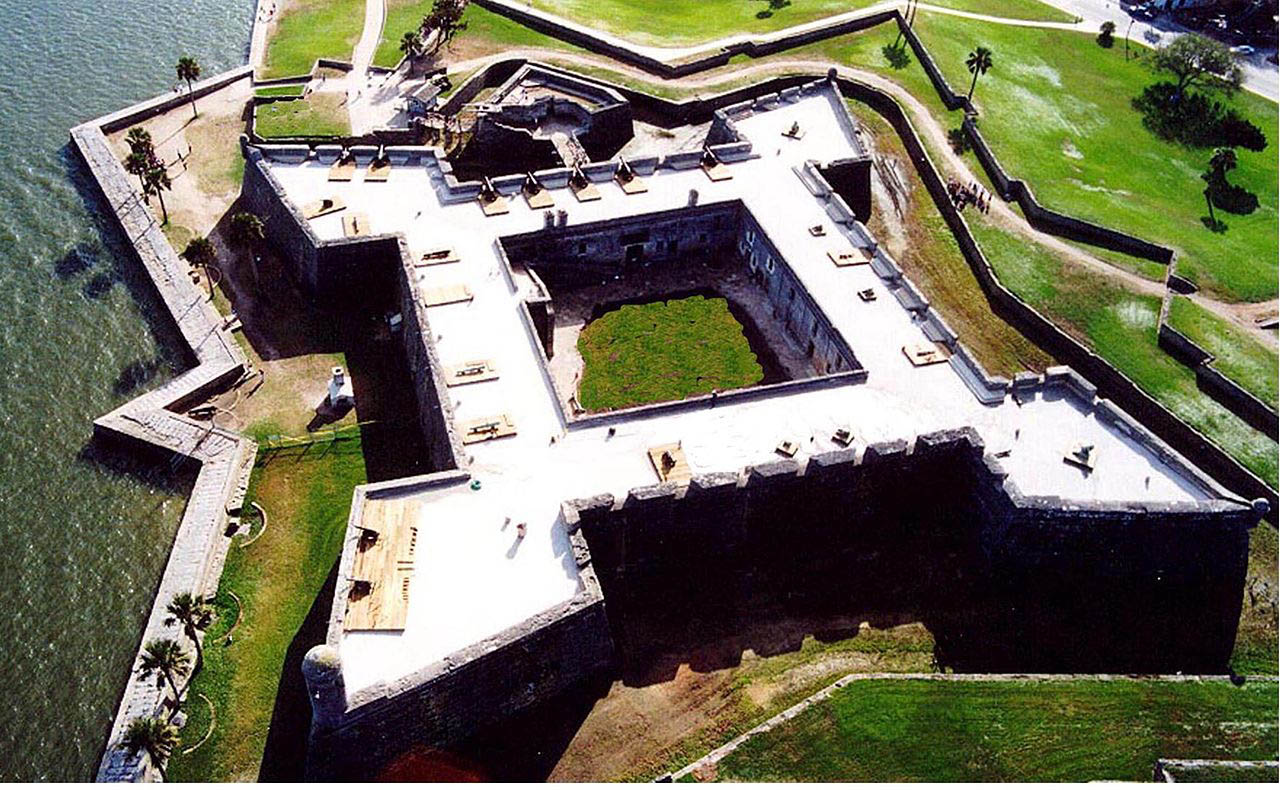
.


The Governor's first duty was to
protect St. Augustine.
The construction of forts was the most costly item in the colonial budget. The
Indians could be bribed to remain peaceful, but English seadogs and pirates
plundering individual Spanish ships along the Florida coast would not be tolerated.
In 1586, the year after the English
attempted to start a colony on Roanoke Island (North
Carolina), an English fleet under the
infamous Sir Francis Drake
attacked St Augustine
and burnt down most of the houses. This humiliating setback convinced the
Spanish to finance a massive fort, Fort San
Marcos. The fort did not prevent the city
from later burnings, but at least the townsfolk had a place to flee.
GOVERNORS AS POLITICIANS
Only a few Florida
governors were outstanding politicians in a giant bureaucracy, but they were required to
administer the law of the Council of the Indies
and resolve only petty problems without the consent of the outside. St. Augustine was a
military outpost and 70% of the populace was on the Royal payroll. Still, town
and sword politics was a serious concern to most Governors..
To improve matters, a town council or
junta of town and military leaders helped solve problems. Unfortunately,
most of the village, from guardian of the convent to harbor master to auxiliary
bishop was on the Governor's payroll. There was little in the rules and restrictions of the Spanish system to promote creative investment. Spanish Florida could not do business with nearby British Georgia.
The Spanish bureaucracy always buried
Governors in paperwork. The autocratic, centralized Spanish system kept St. Augustine supplied
with dispatches and edicts. Spain
assumed that Florida could carry out a law
originally designed for Argentina.
With no audiencia, or civil
court, the Governor was frequently required to settle minor disputes. An
infantry officer was appointed to serve as defense attorney.


GOVERNORS AS BUSINESSMEN
In 1579 the Spanish
Crown took over the financial support of Florida
when no rich nobleman could be located. The Governor was still responsible for
the economy, but others made the key rules. Florida
could not do business with the nearby English colonies nor could English
merchants visit St. Augustine.
Florida would
never show a profit.

The cost of Florida was paid to the Governor in the form
of an annual subsidy or situado.
The salaries of every public employee (maybe 90% of the populace) had to come
from this subsidy. The Viceroy of New Spain paid the situado until 1714, when
after years of complaint of slow service, the annual payments
became the duty of the rich Mexican mining town of Nuestra Senora de Los Angeles. The Mexicans were more
reliable than the Viceroy, but many bad things could happen to a ship sailing
from Veracruz to Havana
to St. Augustine.
Menendez had hoped Florida would
become an agricultural empire, but the Spaniards stayed along the coast where
the soil was sandy. Florida produced the same crops as Cuba, Hispaniola, and Mexico
which meant that investment from outside sources never
developed. The Indian missions provided vital food supplies.
The most successful farms were
developed by Franciscans around
the missions in the fertile Alachua and Apalachee regions. The missionaries
sold fruits and cotton to St.
Augustine. A few civilians began a successful lumber
industry along the St. Johns River. Naval
products, such as tar, pitch, resin, ship masts, and wood pegs, were shipped to
the Atlantic Ocean. Others tried to raise
cattle on the Alachua prairie.
In the 1740's Spanish authorities set
up a trading firm, the Royal Havana
Company, to promote trade and scare off English merchants. The Company
did not offer local farmers a price competitive to English merchants in the Carolinas so the project never materialized.
The Florida
missions were important to Spanish colonialism. It was up to the mission system
to placate the Indians and to develop a profitable trade. To the Spanish
Catholic church, it was their destiny to convert all
the native Americans.
Menendez was a religious zealot, but
he was also obligated to develop a mission system. As a Crown colony, the
Governor paid each incoming friar three reales (37c) per day, with additional
funds for clothing, shoes, and supplies.


The first mission contract was held
by the Jesuits who extended
their activity from the three villages of St. Augustine,
San Mateo, and Santa Elena, to four coastal
forts, on Biscayne Bay, Charlotte Harbor, Tampa
Bay, and St. Lucie Inlet.
In 1572, the Jesuits withdrew because they lacked the manpower to serve all the
migratory Indian tribes. It was no coincidence that when Menendez died, he was
buried in the habit of a Franciscan priest.
The Franciscan order took over the
contract and arrived in 1593 under
Father John de Silva. They started at St. Catherine's Island (Georgia)
as their headquarters, because the neighboring Guale Indians were congenial and influential. Time and distance
allowed the missionary priests complete independence to operate their system.
Convert-making was a slow process.
The Indians had to reside near the wooden mission to study the theology of the
Church by lecture and rote memory. The Franciscans often adopted Indian customs
to survive. The missionary priests always felt the Church in St. Augustine received money at the expense
of the mission system. At its zenith 20,000 Christianized Indians lived around
the missions, but this number was perhaps one-tenth of Florida's
Indian population when Ponce
de Leon arrived.

This conflict within the Church was
often between friars born in the New World, the Creoles, and priests raised in Spain, the Peninsulares. The native-born priests ran the missions and
resented interference from the Diocese of Cuba
and Madrid in India policy. They converted to
phonetics many Indian languages to construct Indian Bibles. Ironically the books
survived while the tribes and native languages did not. Florida was such a
small colony and the risks of ocean travel so dangerous that only two bishops
from Cuba visited Florida, and none came to the
mission system.
When conflict with English farmers
drove the Franciscans out of Guale
Territory, they moved
their center to the Tallahassee Hills, home of the Apalachees. The military
built a fort near Tallahassee
called San Luis and bolstered
the fur trade. Soon, an extensive missionary system stretched along the Florida Trail from St.
Augustine to the Apalachicola
River. Only the intrusion
of English settlers could destroy the zeal of the Franciscans.


CONFLICT WITH COLONIAL RIVALS
CONFLICT WITH THE FRENCH
Spain had ignored the Gulf coast because the
Spanish gold flotilla sailed along the Atlantic coast. The Spanish in the
1690's discovered that the French had sailed down the Mississippi
River in search of warm water ports for its Canadian fur trade.
The French would, therefore, cut off La Florida
from the New Spain (Mexico).
In 1698, the Council of the Indies
sent Andres de Arriola to Pensacola Bay to set up a colony there. The
construction of Pensacola did not scare off the
French who created Mobile in 1702 and New Orleans in 1718.
Serious conflict was prevented when Spain
decided to allow France
two ports provided no French warships would be allowed in the Gulf.
THE ENGLISH THREAT
England, not France,
was Florida's
greatest threat. Since the start of South Carolina
in 1658, English settlers began to invade Florida's mission system. St. Augustine was raided in 1665 and 1668. In
1686 Cuban naval units unsuccessfully attacked Charleston.
Since the Spanish Crown refused to
arm the Catholic Indians, the Governor of Florida was helpless to rescue the gradual
destruction of mission system. Queen
Anne's War (1701-1714) marked the decline of Spanish influence in North America. Governor
James Moore of South Carolina brought
an army of 1200 militia against St.
Augustine. They destroyed the village and destroyed
all neighboring missions.

St. Augustine survived this invasion,
but Moore sent Yamasee and Chisca Indians into the Tallahassee Hills to destroy
the missions there.Spain could not rebuild
the missions, which by 1655 had grown as some seventy friars converted 26,000
Indians.By 17ll, there were just twenty
friars and 400 active converts, most outside St. Augustine.
In 1733, the English founded Georgia
and the situation deteriorated again. Governor
James Oglethorpe organized a huge colonial militia to destroy St. Augustine. The Spanish
could only retreat into their massive fort and wait for a rescue fleet from Havana. The Spanish sent a
fifty-six ship invasion force against Georgia,
but in the Battle
of Bloody Marsh, the English stopped Spain's
last attempt to defend Florida
with an offense.
AN OVERVIEW: SPANISH FLORIDA
For two hundred years
Spain ruled Florida. There was
little to view by the 1750's. St.
Augustine remained a small garrison town of two
thousand soldiers and settlers. The most prosperous merchants were those who
operated food services for the troops. On the Gulf side, Pensacola was barely more than a few wooden
houses and a fort. The mission system was in ruins.
The greatest weakness of Spanish Florida was its
inability to attract families to live there. The rules of Spain forbade the immigration of non-Catholics
and any trade with English America.
Spaniards refused to settle in Florida.
Investors felt their money would be better spent in Cuba
and Mexico.
This was Spanish Florida, obviously under-populated and
underdeveloped. Its cultural and economic contributions limited to a few
places. This would not have been a dangerous situation if the growing English
colonies would not be so close and prepared to one day overrun the Florida peninsula.


![]()











![]()
![]()



![]()


![]()
